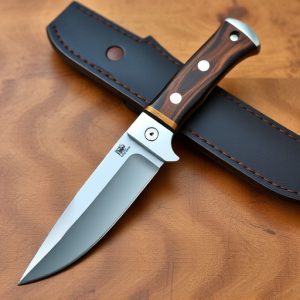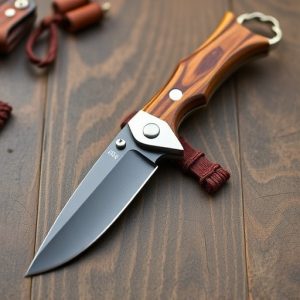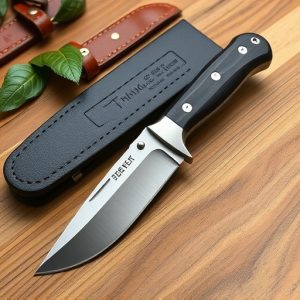Expert’s Guide to Selecting & Maintaining Premium Fixed Blade Knives
When purchasing high-quality fixed blade knives for sale, prioritize robust construction, premium ma…….
When purchasing high-quality fixed blade knives for sale, prioritize robust construction, premium materials like high-carbon stainless steel, and ergonomic design for comfort and control. These knives are essential gear for outdoor activities such as hunting, fishing, camping, and survival situations. A full tang structure enhances the knife's strength and longevity, while the handle should provide a secure, non-slip grip to reduce hand fatigue. Balance between the blade and handle is key for both precision cutting and ease of handling. Consider the blade shape, with a drop point being versatile for many tasks. A durable sheath is also necessary for safety and storage.
Custom fixed blade knives come in various high-quality steels and ergonomic handles made from materials like wood, bone, or synthetics like micarta or G10. Blade shapes range from drop point for versatility to spear point for precision, each designed for specific tasks. Safety features such as handguards and lanyard holes are important additions. Sheaths can be made of leather, nylon, or kydex and offer different carrying options like belt, pocket, or MOLLE system compatibility.
To maintain the knife's condition, a routine of cleaning with a soft brush and lukewarm water, drying with a soft cloth, and lubricating the pivot pin is recommended. Regular sharpening with a honing rod and fine grit sandpaper or stone will keep the edge sharp. Proper storage in a specialized sheath protects the knife from damage. By adhering to these maintenance practices, your fixed blade knife will remain a reliable tool for all your outdoor adventures.
Explore the world of custom fixed blade knives, a realm where quality and craftsmanship converge. This article demystifies the intricate journey from selection to maintenance of these versatile tools. From discerning the right fixed blade knife for sale to understanding the design elements and material considerations that define excellence, we delve into the essential aspects of owning a finely-crafted blade. Furthermore, learn the art of preserving your custom fixed blade’s edge through meticulous care and maintenance, ensuring it remains a reliable companion for years to come.
Understanding Fixed Blade Knives for Sale: A Buyer's Guide to Quality and Craftsmanship
When venturing into the realm of fixed blade knives for sale, it’s crucial to have a discerning eye for quality and craftsmanship. These blades are designed for durability and reliability, making them indispensable tools for various outdoor activities, from hunting and fishing to camping and survival situations. A high-quality fixed blade knife typically features a full tang construction, which ensures the strength of the blade and its handle. The steel used in its forging is another critical factor; look for reputable brands that use high-carbon stainless steels known for their resistance to corrosion and retention of sharpness over time.
The handle material also plays a significant role in the overall performance of the knife. A comfortable, non-slip grip not only enhances control but also reduces fatigue during extended use. Additionally, the balance between the blade and the handle is vital for precision and ease of use. When examining fixed blade knives for sale, consider the blade shape and size according to your intended purpose. A versatile drop point shape is popular due to its excellent combination of strength and utility, while a longer blade might be preferable for tasks requiring more leverage or reach. Always ensure that the knife comes with a secure sheath designed to protect both the user and the blade when not in use. By focusing on these aspects, you can select a fixed blade knife that meets your specific needs and stands the test of time.
The Anatomy of a Fixed Blade Knife: Design Elements and Material Considerations
When acquiring a custom fixed blade knife, understanding its anatomy and the design elements that go into its creation is crucial for both functionality and satisfaction. The blade, which is the primary component, is typically crafted from high-quality steel, with options ranging from stainless to tool steels, each offering different characteristics in terms of hardness, edge retention, and resistance to corrosion. The shape and grind of the blade can vary widely depending on its intended use; common styles include drop point for all-around utility, spear point for precision tasks, and clip point for a blend of both.
The handle of a fixed blade is ergonomically designed to fit securely in the hand, providing a comfortable grip that can withstand rigorous use. Materials used for handles can include everything from natural materials like wood and bone to modern synthetics such as micarta or G10. These materials not only add to the aesthetic appeal but also offer durability and a non-slip surface even when wet or sweaty. The guard, which protects the hand from slipping onto the blade, is an important design element that must be thoughtfully integrated into the handle. A lanyard hole may also be present, allowing for the attachment of a cord or strap for extra security and ease of retrieval. The sheath, which holds and protects the knife, is another critical aspect, often made from leather, nylon, or kydex, and can be designed for belt carry, pocket carry, or MOLLE systems, depending on the user’s needs. With fixed blade knives for sale ranging from artisan to production models, the variety of designs and materials ensures that every enthusiast can find a knife that suits their specific requirements and preferences.
Mastering the Art of Custom Fixed Blade Knife Maintenance and Care
When it comes to maintaining custom fixed blade knives, attention to detail and regular upkeep are paramount to ensure longevity and optimal performance. The process begins with a thorough cleaning after each use. Knife enthusiasts should gently remove any residue, dirt, or debris using a soft-bristled brush and lukewarm water. This not only preserves the blade’s sharpness but also prevents corrosion by removing salt, grime, and other abrasive substances that could mar the knife’s finish or weaken its structure over time.
After cleaning, drying the knife is crucial to prevent rust or mold growth. Use a soft cloth to pat the blade and handle dry. Lubricating moving parts like the pivot pin with a suitable lubricant can maintain smooth operation. Regular sharpening is another key aspect of care for custom fixed blade knives for sale. A honing rod should be used periodically to realign the edge, while a sharpening stone or fine grit sandpaper is necessary to restore the cutting edge when it becomes dull. Choosing the right angle and consistent technique are essential to avoid damaging the blade. Additionally, storing the knife properly, preferably in a sheath designed for that particular model, can protect it from accidental nicks and scratches. Proper care and maintenance not only extend the life of your custom fixed blade knife but also ensure it remains a reliable and trustworthy tool for various tasks.


